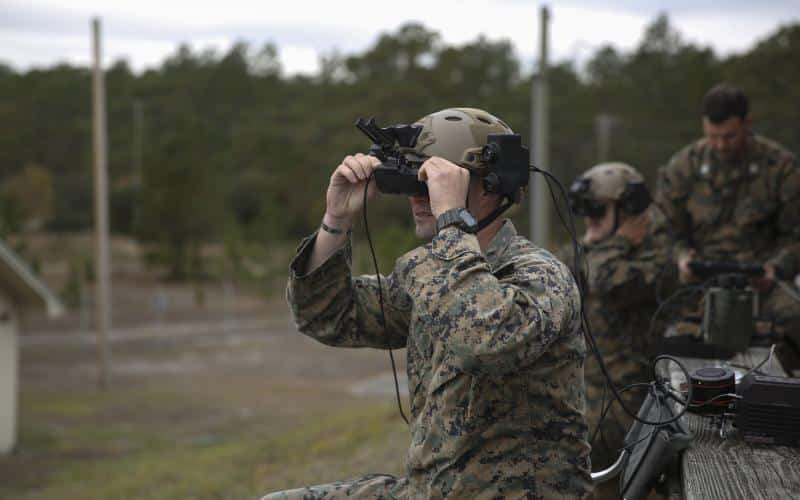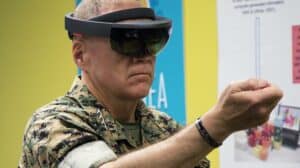Perhaps it wasn’t much of a surprise to hear that Microsoft landed a $480 million augmented reality military contract. The tech industry has always had its ties to the battlefield. But it’s definitely a boost for the HoloLens mixed reality headset which has been around since March 2016 (when the Development Edition shipped).
Every now and then there seems to be an interesting story about the HMD, but Microsoft hasn’t made a major effort to push it into the learning environment or the workspace. There’s a few signature projects around but nothing more.
Here’s the essential details on the military contract from Bloomberg.
With the contract, the Army immediately becomes one of Microsoft’s most important HoloLens consumers. It expects devices to vary from their consumer-grade counterparts in a handful of key respects. In a document shared with companies bidding on the contract, the Army said it wanted to incorporate night vision and thermal sensing, measure vital signs like breathing and “readiness,” monitor for concussions and offer hearing protection. It said the winning bidder would be expected to deliver 2,500 headsets within two years, and exhibit the capacity for full-scale production.
The U.S. Army may purchase up to a 100,000 of the new devices and is looking for “full-scale production.” Given that total HoloLens sales are only around 50,000 for two and half years (according to Microsoft last spring), that’s a gamechanger.
Multi-user, multi-soldier?

Clearly, the new HMDs would differ from the current HoloLens model. This is not just about using the device for training simulations but out in the field.
With obvious features like night vision and thermal sensing, you wonder if the Army is also thinking about potential collaborative uses. Microsoft released another video in the spring that highlighted its Mixed Reality device as a virtual collaboration platform. Seeing a miniature realistic avatar Alex Kipman remotely standing on a conference table is impressive. Though we’re still some ways from making this a live event.
HoloLens is already used at NASA’s Jet Propulsion Lab with the Onsight program. That software lets scientists remotely meet and collaborate on the Martian surface. Beaming people into a battlefield – or temporarily out of it – to discuss strategy could be a powerful feature.
Who lost that augmented reality military contract?
With Microsoft landing that contract, others lost out. Neither Google or Apple have an AR headset ready to go, though both are working on projects. There are a few other AR B2B vendors who made a play for this, but the big loser is Magic Leap.
In truth, the recently released Magic Leap One felt like an HMD that you could see in military use (despite its steampunk ethos). The challenge is that Rony Abovitz and company pushed their mixed reality headset as a consumer and entertainment device. Microsoft was way ahead in positioning HoloLens in the business and manufacturing space as Gizmodo noted last year. In fact, Alex Kipman has said the consumer market can’t be targeted until they produce an HMD for less than a $1,000.
The other question here is why did the military turn down the possibility of AR Glasses in the next year or two? Is the technology not ready for serious use in the field? Do they need a full mixed reality environment? Keep in mind that with HoloLens, you’re wearing an entire computer on your head – which is not the case with AR Glasses.
From the military to the public
We doubt Microsoft’s augmented reality military contract will have any impact on the forthcoming HoloLens 2 for the consumer market. But the research funded by this project will undoubtedly influence future versions of their mixed reality HMD.
As is often the case, what starts out as advanced technology in the military ends up in the public arena. Just take a look down at your desk. Your technology is a bundle of services that at some point in the past had either military connections or origins. Just look at the fascinating origins of GPS which had its start in the Cold War with Sputnik, MIT scientists, and the military.
And that leads to an interesting situation. Like our Smartphones, our future augmented reality HMDs will have both serious and frivolous uses. We may even see some initial resistance to their use in the classroom and corporate environment.
There is still an ongoing debate as to whether Smartphones enhance or kill productivity in the workplace. But of course, we couldn’t see ourselves working without them.
AR glasses and headsets may have to go through a similar period of conflicted adoption. And it will be a much sharper debate. You know when someone is looking down at their phone instead of engaging with you. With AR glasses, you’ll never know.
Immersive technology begins as an isolating device – the classic image of a person stumbling around in a VR headset. We’ve all heard the criticisms. But in the end, it will be so deeply integrated into our lives that we’ll hardly know it’s there. And the military will have played a role in making that happen.
Emory Craig is a writer, speaker, and consultant specializing in virtual reality (VR) and generative AI. With a rich background in art, new media, and higher education, he is a sought-after speaker at international conferences. Emory shares unique insights on innovation and collaborates with universities, nonprofits, businesses, and international organizations to develop transformative initiatives in XR, GenAI, and digital ethics. Passionate about harnessing the potential of cutting-edge technologies, he explores the ethical ramifications of blending the real with the virtual, sparking meaningful conversations about the future of human experience in an increasingly interconnected world.

